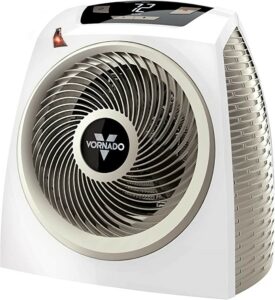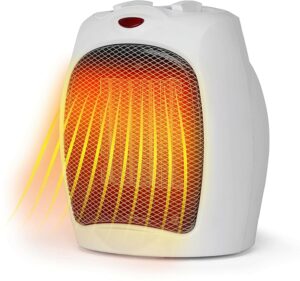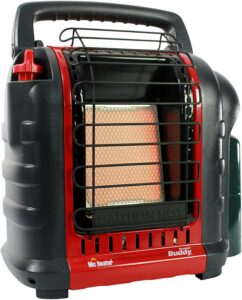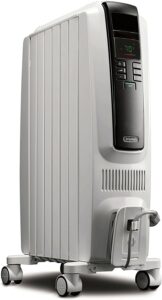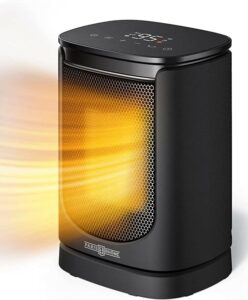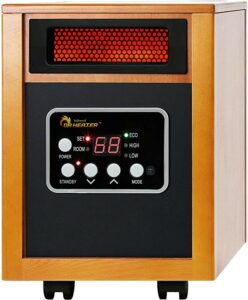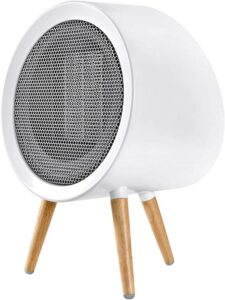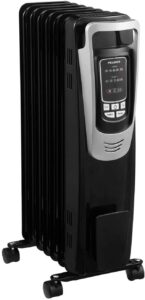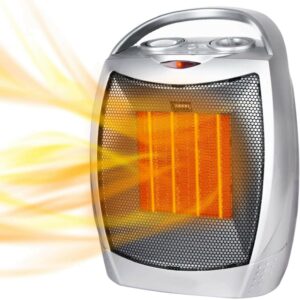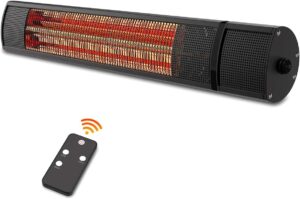Indoor heaters offer more than just comfort.
Also known as space heaters, these devices are almost lifesavers in chilly places where it is a struggle to keep the indoors warm.
Furthermore, as most modern space heaters work with electricity, they don’t pollute your house like the traditional woodfire. With them, your family won’t shiver from the cold or sneeze because of the smoke.
This article will discuss everything you need to know before buying an indoor heater. At the same time, we will look at the best indoor heaters you can buy in 2022.
- Compatible with major cable internet providers including Xfinity, Spectrum, Cox and more. NOT compatible...
- [Compatibility] 12V Power Supply Adapter Compatible with Netgear, Linksys, Asus,Motorola, Motorola/Arris...
So, let’s get started!
How Do Indoor Heaters Work?
Indoor heaters are mostly used as secondary appliances in houses where central heating isn’t enough. They are portable and do a great job heating specific parts of a room.
Residential indoor heaters work with electricity or gas. They have a heating element that converts electricity or gas into heat energy, and a mechanism to transfer the heat to their surroundings.
Based on how they work, we can group them into seven different categories:
- Convection Heaters
- Infrared Heaters
- Fan-Forced Heaters
- Oil-Filled Heaters
- Propane Heaters
- Halogen Heaters
- Panel Heaters
What Is the Best Indoor Type of Heater?
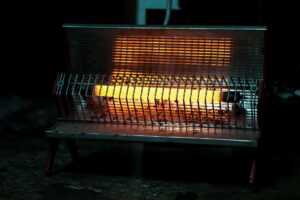
The answer depends on your requirements. You need to look at the advantages and downsides of all the devices and choose the one that fits your needs.
Convection Heaters
Convection heaters are based on a scientific phenomenon called convection, which is also the theory behind microwave ovens.
These heaters warm the air around them. Then, the warm air rises and is replaced by cold air until every air molecule inside the room turns hot.
Pros
- They can be mounted anywhere in the house.
- They can warm up the room evenly.
- These heaters make less noise and work quickly.
- They have minimal maintenance requirements.
Cons
- Convection heaters consume more energy than their infrared counterparts.
- Most models have a limited range and aren’t suited for bigger spaces. But, some devices can cover a large area.
- Air needs to circulate throughout the machine, so certain objects near them can block airflow.
- The time and energy consumed for heating increase with the coldness of the air around the machine
Infrared Heaters
Infrared heaters emit infrared waves. These waves aren’t detectable by the naked eye but can easily pierce through your body. And when they do that, they make your molecules move faster, increasing the heat inside you.
The way these machines work is almost like the sun. It’s worth noting that they don’t warm the air but the objects around them.
Pros
- They work instantly, as the warmth is conducted directly to the object’s body.
- These devices are silent and environmentally healthy. They don’t produce pollutants.
- Minimal maintenance is required as there are fewer movable parts.
- They use less energy than other heaters, and many affordable models are available.
- The rays themselves don’t cause a fire.
Cons
- Safety issues. They use a coil to deliver warmth, which could get very hot.
- The heat is lost the moment the heater turns off.
- Studies show that infrared rays may cause various skin and eye issues when constantly in contact with the body.
- Infrared heaters have a limited range and aren’t very good if you want to heat up an entire area.
Fan-Forced Heaters
Fan-forced heaters use a fan to deliver and transfer heat. The fan is run over a heating element, which allows the heat to travel outside the machine and into the room.
The heating element can be an electrical foil, hot water, gas, kerosene, etc. These heaters have both industrial and residential models.
Pros
- Fan-forced heaters are less expensive because of their simple construction.
- They distribute heat throughout the room evenly.
- They are easy to install.
- They work quickly.
Cons
- They are usually more expensive to operate as they consume more electricity.
- A fan-forced heater can be noisy because of the rotating fan.
- The range depends on the size of the model.
- Since air travel throughout the room, allergens and dust particles can tag along, making you sick.
- These devices are more susceptible to collecting dirt. So, they need regular cleaning and maintenance.
Oil-Filled Space Heaters
Contrary to what many think, oil-filled space heaters don’t burn oil. Rather, a diathermic oil is used as the buffer for the heating element.
An oil-filled heater consists of metal columns inside, which oil can move freely. First, the oil is heated by a heating element, and the heat in the oil travels to the metal walls. Then, the heat from the metal wall is transferred to the air via radiation.
Pros
- More energy-efficient since once you heat the oil, it retains its temperature for a long time.
- These heaters continue working even when turned off.
- They offer a better range than other heaters. Some of the best indoor electric heaters for large rooms are in this category.
- They keep the air healthy as they don’t transfer germs or affect the air humidity.
- They’re relatively safe, as the device surface isn’t as hot as other heaters.
- Oil-filled space heaters can fit anywhere and don’t make a lot of noise.
Cons
- They’re generally more expensive, as the technology is new.
- Bulkier sizes make them harder to carry around the house.
- Oil takes a lot of time to heat up.
Propane Heaters
Propane heaters burn liquid propane to heat the room. Experts consider them to be the safest and the most efficient gas heaters.
A propane heater can be automatic, or you may need to start it manually with a lighter. Furthermore, it uses electromagnetic radiation to transfer heat and can come with a blower.
Pros
- It is environmental-friendly, as liquid propane doesn’t produce harmful elements like natural gas.
- Propane devices are more energy-efficient than the ones that use electricity.
- They generate more warmth than other heaters, and it stays even after the appliance is turned off.
- These devices can be taken outdoors and in places where you don’t have an electric socket, including a garage, tents, etc.
Cons
- They require refills.
- You need to do regular maintenance on the HVAC unit.
- Propane heaters take longer to heat than other heaters.
- Sometimes, they can heat more than needed, as they have a very wide range.
- Even if rare, propane leaks are still a possibility, which can cause big fires and explosions.
- Propane can cause carbon monoxide poisoning if it burns with incomplete combustion. So, you may need to install a CO detector in the room where you want to use the heater.
Note: Propane heaters are available for both indoors and outdoors. If you want to use them indoors, make sure you buy one with a vent.
Halogen Indoor Heaters
Halogen indoor heaters are one of the most eco-friendly appliances out there. They are infrared heaters that use halogen lamps instead of electrical coils, which are more energy-efficient and have a longer life.
Pros
- They are cheap to buy and operate.
- Halogen indoor heaters are very portable, and bigger models are also available for outdoor use.
- These heaters can produce heat instantly.
- They are very energy-efficient, especially if you only want to heat up a small space.
Cons
- A study shows that halogen heaters can release large amounts of UV radiation that could cause skin cancer on prolonged exposure.
- The bulbs can make your skin burn during contact. You need to be careful around kids.
- These devices are small and have a limited reach.
Panel Heaters
A panel heater is also known as a wall-mount heater. Looking solely at how it works, it’s like a combination of an oil-filled and convection heater. Inside the device, the rods are heated like an oil-filled heater, but the heat is transferred by convection instead of radiation.
Pros
- They are easy to install.
- Panel heaters are noiseless.
- Since the heat is generated through convection and not forced air, allergens and mold don’t travel through space.
- They are generally safe for children since they can be mounted on places kids can’t reach.
Cons
- Most panel heaters don’t produce as much heat as other devices.
- Lack of convenience since only a limited area of your room will be warm, and moving the device is difficult.
Features to Consider Before Buying
Here are the most common features you should look for before buying an indoor heater.
Power Consumption
Higher power consumption gives more warmth, but also increases your electrical bills.
You should consider your room’s size when deciding on the heater’s wattage. For a small room, something around 1500W is more than enough.
Some good heater models have in-built thermostats with adjustable power consumption features. Generally, the low power meter is set at 750W and the high at 1500W.
Range
While the range is directly proportional to the power consumption, you should ensure that the heater covers the maximum range for its power.
A good range is one sq ft for every watt. You also need to check if the heating capability deteriorates as you go farther from the heater, even within the area it’s supposed to cover.
Some heaters also have 360-degree coverage, but they consume more electricity.
Safety
An automatic power cut-off feature during overheating is necessary for every indoor heater. This feature avoids burning or the explosion of the device.
If you want to buy a non-wall mountable heater, please make sure it has a strong base. You will also require an automatic turn-off feature in case it tips over.
Other features to look out for in an indoor heater are child lock, insulation, automatic thermostat, etc. Especially if you have kids or pets, look for a heater with a ceramic face, as its surface isn’t as hot as metal.
Noise Levels
The noise level in most heaters is given in decibels (dB). The lower this measurement, the quieter the device.
For reference, a vacuum cleaner at a distance of 1m makes a noise of 70dB. Conversational speech is 60dB, breathing 10dB, and an average home is 50dB.
If you plan to use your space heater during the night, make sure it’s less than 30dB, as it’s the average sound level in a quiet bedroom.
Quick Comparison Chart for the Best Heaters
Before going through all the items in detail, here is an overview of the products that we have listed in the article. Each of them has been picked carefully based on their reviews and after testing them personally.
| Product | Type | Size | Weight | Color Availability | Warranty |
| Lasko Designer Oscillating Heater | Convection | 10 x 10 x 16 inches | Ceramic | Gold | 3 Years |
| Vornado AVH 10 Heater | Forced Air | 11.7 x 9.3 x 12 inches | Plastic
|
White | 5 Years |
| Black+Decker Portable Space Heater | Forced Air, Convection | 10.9 x 8.3 x 8.3 inches | 2.3 lbs | Black,White | 1 Year |
| Mr. Heater F232000 MH9BX Buddy | Propane | 7.7 x 13.4 x 15 inches | 1 lbs | Red and Black | 1 Year |
| De’Longhi TRD40615E | Oil-Filled | 16.4 x 10.3 x 26.1 inches | 26.6 lbs | White | 3 years |
| PARIS RHÔNE Space Heater | Forced Air | 6.1 x 6.3 x 10.04 inches | 3.9 lbs | Black | 1 Year |
| Dr Infrared Portable Space Heater | Infrared | 13 x 12.5 x 17 inches | 24 lbs | Wooden and Black | 3 years |
| GAIATOP Space Heater | Forced Air, Convection | 8.3 x 6.96 x 7.63 inches | 2.2 lbs | White with Wooden Colore Legs | 1 Year |
| PELONIS Electric 1500W Oil Filled Radiator Heater
|
Oil Filled | 13.78 x 11.02 x 25.19 inches | 16.09 lbs | Silver and Black | 1 Year |
| Lasko Bladeless Ceramic Heater | Convection | 10.8 x 27.17 x 9.16 inches | 9.4 lbs | Silver | 3 Years |
| Brightown Portable Electric Space Heater 1500W/750W | Forced Air | 8 x 6 x 10 inches | 2.99 lbs | Silver | N/A |
| GEEPAS 800W Quartz Halogen Heater | Halogen, Infrared | 13 x 7.8 x 5.5 | 1.10231 lb | White | 2 Years |
Best Indoor Heaters You Can Buy in 2022
Now that we have cleared the air about what indoor heaters are and the things to consider before buying one, let’s look at some of the best models on the market.
Lasko Designer Oscillating Heater
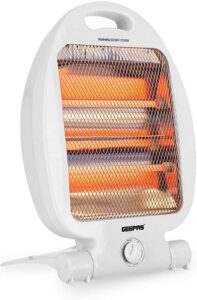
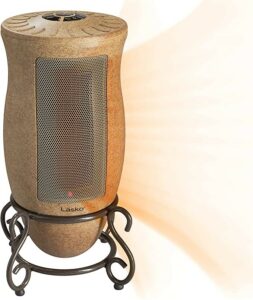
With smooth contours and an attractive metal scroll base, the Lasko Designer almost looks like an antique. But despite its retro appearance, it’s one of the most modern and efficient devices out there.
It is an oscillating heater, meaning it covers a wide range for its size. For 1500 watts of power, it can comfortably warm about 150 sq feet. Some have reported the device to be effective up to 250 sq feet, making it one of the best indoor electric heaters for large rooms.
The Lasko Designer has an adjustable thermostat and two heat settings. It also has an automatic timer that can turn off the appliance once it reaches the desired temperature.
In terms of safety, there is a ceramic element, automatic heat protection, and cool-house touching.
Pros
- Quiet, even though there is an oscillating function
- Classic look
- Makes the room warm fast
- Adequate security features
- Affordable
Cons
- No remote control
- Only available in beige
- There are only presets for the temperature control
Vornado AVH 10 Heater
The Vornado AVH10 Vortex Heater is one of those devices that may not be very photogenic. But once you look at it closely, it offers more than the cheap and readily available models of air heaters.
Vornado AVH10 comes with an LED screen from which you can select the desired temperature of the room and power output. Furthermore, there are two heat settings; you can decide if you want the power consumption to be high (1500W) or low (750W).
Another thing the Vornado does well is mobility. There is an integrated carrying handle and hidden cord storage, both of which can be beneficial when you are moving the device from one room to another.
The cool-touch case and the automatic shut-off feature during excessive heat and tipping over make this device safe to use in your home.
Pros
- Adjustable heat settings
- Easy to move
- Less Noise
- LED display
- Three safety features
Cons
- Isn’t suitable for huge spaces
- Even with the safety features, you need to be careful where you place it, as kids and pets can easily knock it over.
Black+Decker Portable Space Heater
The Black+Decker Portable Space Heater’s reviews on the web are over the roof, and once you use it, you may just say it’s the perfect warming device for small rooms.
Its compact size makes this appliance easy to carry. Furthermore, it has a six-foot power cord, so it can be placed away from the outlet.
There are two heat settings – 750W and 1500W and even a fan feature, which helps you regulate the temperature and power consumption.
The Black+Decker Portable Space Heater has a stable base and an auto-tip over shut-off feature. There is also overheat protection.
Pros
- Portable and light to carry around
- Easily covers the average range of 150 square feet for its power consumption
- Simple to use as there are only two buttons
- Great price
- One-year warranty
Cons
- Relatively noisy
- Need to keep away from kids as touching the heater causes burns
- The fan isn’t as strong
- Not very useful for bigger spaces
Mr Heater F232000 MH9BX Buddy
The aggressive design of Mr Heater F232000 MH9BX Buddy could overwhelm some people.
However, the device is still portable and a great option, especially for adventure seekers.
It is easy to carry with a modest weight of 1 pound and a grip handle. Furthermore, the base is wide enough for the device to be placed anywhere indoors or outdoors.
There are two heat settings, 4,000 BTU and 9,000 BTU. The Mister can heat up to 225 sq ft, making it effective for bigger spaces like garages and tents.
You can light up the heater by simply rotating a knob. You could expect a little more than 2 hours of heat on high and about 4-5 hours on low with a single refill.
While Mr Heater is safe with the auto shut-off feature during tipping over, it is still advisable you use a CO alarm if you are using it indoors. And again, keep it away from children and pets.
Pros
- Great energetic design
- Extremely efficient, almost 100%
- High range of heat
- Portability
- Works without electricity
Cons
- Requires propane refills, which may not be readily available everywhere
- You need a CO monitor if you are using it indoors
- Can cause burns
De’Longhi TRD40615E
De’Longhi is a popular brand for oil-filled heaters. This particular model, the De’Longhi TRD40615E, comes with a digital thermostat from which you can control and get the desired temperature between 50 and 84 degrees Fahrenheit.
The power output can be up to 1500W, and the range is up to 144 sq feet. Furthermore, there are three heat settings and an eco feature that allows you to balance warmth and electricity use.
With a metal body and a cool surface temperature, we can say that De’Longhi TRD40615E is sturdy and safe if you have kids or pets. There is also a thermal cut-off function in case overheating occurs.
Pros
- A strong device that doesn’t need refills
- Long-lasting warmth even after closing off
- Simple controls and highly flexible temperature controller
- Good security features
Cons
- Some units have been seen to leak oil
- May smell during initial uses
- Offers steady radiant heat. It may not be the best option for those looking for toasty heat.
PARIS RHÔNE Space Heater
The PARIS RHÔNE is a tower design space heater that comes in two sizes; 16 and 18 inches. This convection device has two heating modes, high (1500W) and low (900W). Furthermore, it comes with a precise built-in temperature sensor that allows you to achieve the best possible temperature while saving electrical bills.
The PARIS RHÔNE is an oscillating heater, and, with a 70-degree wide-angle, the coverage is about 20% higher than other models with similar power output. Hence, it is one of the best indoor electric heaters for large rooms.
Furthermore, the oscillation allows warm air to spread more evenly inside its range, which helps to keep the room consistently warm. Also, the appliance comes with a remote control and an LED screen, offering even more in terms of convenience and comfort.
Safety features include tip-over protection, 12 hours timer, 24-hour auto turn-off, and overheat protection.
Pros
- Absolutely no noise
- Security features that make it pet- and kid-friendly
- Great heating performance in terms of range and time
- Remote control
Cons
- The controls can be a little difficult to use
- Only available in black
Dr Infrared Portable Space Heater
Dr Infrared Portable Space Heater is one of the best of its kind. It is extremely efficient; it uses about 100% of the heat produced; thus, it is known to offer more heat than other 1500W heaters.
There are three heat settings: auto, high (1500W), and low (750W). The auto mode selects a temperature between 50-86 degrees Fahrenheit based on your surroundings. Furthermore, the heat is consistent; the company actually claims that the heater is effective up to 1000 sq ft and heats everything equally.
While the attractive vintage looks of the heater may not be for everyone, its compact size allows you to tuck it in the corner of the room without disturbing the ambiance.
With a box design, the Dr Infrared Heater is difficult to tip over. But even if it does, there is an automatic turn-off feature as well as a schedule timer and overheating control, which make it safe to use.
Pros
- Best heater for energy bill savings
- Attractive retro design
- Remote control
- No noise
- Box design and adequate safety features
Cons
- No handles, but wheels. It can be difficult to move the device when you need to climb stairs
- Heavy to lift
- Need to turn on manually before using a remote control
GAIATOP Space Heater
GAIATOP Space Heater is the one to go for if you are looking for a portable, yet extremely powerful heating device. Even though it is only about 7.63 inches tall, it can heat up to 70 degrees Fahrenheit.
The portable size of this heater makes it great to be used as a table heater for a bedroom, office, or even a bath. Additionally, even if it makes a noise, it’s below 35 dB – more like a white noise, which may even be relaxing for some during meditation or work.
GAIATOP has three heating presents, including 1000W high, 600W low, and a cool blow fan. You can feel the heating effect quite fast after opening the heater.
The ceramic element makes it cool to touch, and there’s an automatic power-off if the device tilts 45 degrees. Furthermore, it has a wooden stand with non-slip silicone on the bottom, so it’s stable.
Pros
- Compact size
- Easy to Use
- Great heating performance for the price
Cons
- Can be unsafe for children since anyone can carry it
- Isn’t really suitable for huge spaces
- Isn’t completely silent
Lasko Bladeless Ceramic Heater
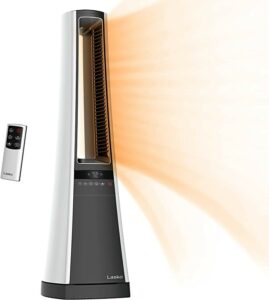
Lasko Bladeless Ceramic Heater has two heat settings, 1500W high and 1000W low. It has a great range, heating rooms up to 300 sq feet at a temperature between 70 and 85 degrees Fahrenheit.
Like other tower heaters, Lasko Bladeless Ceramic Heater helps save space in your room. It can easily be fitted anywhere and has a unique triangle-rectangular design, making it aesthetically stunning for every space.
Even if the filter in the AW300 needs to be vacuumed, it is easy to do so. In addition, it oscillates, which means the heat is even throughout the space.
Lasko Bladeless Heater comes with a timer, and it closes automatically when overheating. In addition, it has a ceramic body. But you still need to be careful, as there is no automatic turn-off feature during tipping.
Pros
- Great design
- Remote control
- Lightweight
- Quiet for a forced-air heater
Cons
- Doesn’t close off automatically when the device tilts
- You need to clean the filter
PELONIS Electric 1500W Oil Filled Radiator Heater
PELONIS Electric 1500W Oil-Filled Radiator Heater is all about flexibility. It has three heat and five temperature settings, making it very effective when setting the warmth to your preference.
The three heating options are 900W low, 1500W high, and an automatic mode that selects the best power output based on the surrounding temperature. Furthermore, you can achieve steady temperatures of 65F, 70F, 80F, and 85F, which you can control with the thermostat and view on the LCD screen.
This device is big, but mobility isn’t an issue since it comes with 4-Swivel Caster Wheels. Moreover, there is a power cord storage. The hardware components are also strong, and with proper maintenance, the device will be usable for years.
In terms of safety, there’s over-heat protection and automatic closing when tipping over. Furthermore, the power indicator light will also be helpful for safety since the heater is silent; otherwise, you may not know when it’s open.
Pros
- Silent
- Many heat settings
- Remote Control
- Gentle heat that doesn’t dry out the air
Cons
- Takes some time to heat
- Should have had less than 900W power voltage on the low
Brightown Portable Electric Space Heater 1500W/750W
Brightown Space Heater stands out in the category of forced air heaters because of its durability. The main material is ABS (Acrylonitrile Butadiene Styrene), which is stronger than PP (Poly Propylene) used in most other indoor heaters. Even the cord is made of rubber instead of PVC, making it less likely to break.
Another one of the best indoor electric heaters for large rooms, the Brightown Portable Electric Space Heater can heat up to 200 square feet in minutes. In addition, the noise is less than 45 decibels.
There are two options for heat on this device, including 750W and 1500W. You can adjust the temperature up to 158 degrees Fahrenheit.
Security features in the heater include overheating protection, automatic closing off during tilting, and a safety PTC element that helps make the surface temperature cool.
Pros
- Small size and easy to handle
- Less likely to tip over and comes with protection
- Affordable
Cons
- Inconsistent warming as you move away from the device
- The anti-tip-off feature could do a better job since it is just a plastic knob on the bottom of the heater. If that plastic breaks off, there is no such feature.
- Not completely silent
GEEPAS 800W Quartz Halogen Heater
GEEPAS 800W Quartz Halogen Heater was designed for personal use in a small space. Honestly speaking, the name could be a little misleading as the device offers two heat settings, including 300W and 600W.
But despite that, it honestly is a great device that just does the work it is supposed to do perfectly. Now, it won’t toast the entire room but will keep you and your pet or child warm when sitting in front of the device.
There’s a tip over-switch and a metal grill in front of the halogen for safety. Similarly, there is an automatic close-off feature when the radiator overheats. The alarming orange glow will also help keep the kids and pets away from touching the device.
Pros
- Great for small space
- Affordable Prices
- Easy to carry around
Cons
- Little heating range
- Heat isn’t that intense; you may still need to stay inside your blanket
Safety Tips While Using Indoor Heaters
It’s no doubt that indoor heaters are great devices, but you still need to follow some safety rules while using them, such as:
Keep Distance
The closer you are, the higher your risk of getting caught if something wrong happens. The National Fire Protection Association recommends keeping a heater at least 3 feet away from anything that can burn, including furniture, drapes, and people.
In addition to this, you should make sure the heater isn’t placed near highly flammable objects such as gas or oil.
Keep Away from Kids and Pets
This is a no-brainer but worth repeating. If you have kids and pets, getting wall-mountable convection or radiant heaters is recommended. Also, don’t forget to teach your kids about electrical safety, and buy a device with a cool surface, which is usually made of ceramic.
Don’t Use Extension Cords
Never connect your heater to an extension cord or power strips. While some cords can be stronger than others, you should still play it safe by using a wall socket. Some models may have instructions about this on their user manual.
Be Responsible About Electrical Safety
This includes the following:
- Check the heater’s wire and prongs regularly for damage.
- Never hide the wire inside a rug or a blanket.
- Place your cord in a way it doesn’t trip anyone.
- While using, place the heater on a smooth, hard surface.
Be Careful of Overheating Devices
In case you notice overheating, close the device immediately. Get rid of it if a warranty isn’t available. Not to mention, never buy a second-hand indoor heater. The risks of a damaged heater aren’t worth the lower price.
Check for Safety Certification
Especially if you are buying from your local dealer, look at the safety certification. The accreditation agency may vary based on your location, but make sure it is genuine. In the USA, it is done by the U.S. Consumer Product Safety Commission (CPSC).
Never Leave a Heater Alone
Always remember to close a heater before going outside. You also need to ensure that there is an escape route in case the appliance catches fire. Moreover, remember that no matter what many advertisements show, electrical heaters aren’t supposed to be open when you go to sleep.
Safety Tips for Gas Heater
If you are using a propane heater, you need to follow all the above guidelines and more, including:
- Turn off the device if the flame is red, orange, or yellow instead of blue. Call maintenance experts.
- Don’t spray air fresheners, deodorants, or other chemicals near a propane heater, especially when open.
- Vent your device and install it as far as you can from combustible items.
Indoor Heaters vs. Air Conditioners: Which One to Go For?
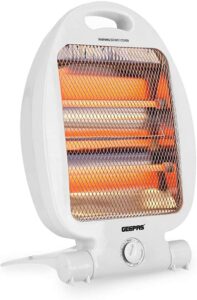
By design, indoor heaters are built to heat smaller spaces than an air conditioner. Hence, they are smaller and cheaper.
Looking through the web, we found many sites that noted how air conditioners are more energy-efficient. While this is true, it doesn’t tell the entire story.
You see, once you operate an air conditioner, you will need to heat the entire room – even the places that don’t need to be warm. So even if these devices are more efficient while converting electricity to heat, they result in higher electricity bills, as they have a higher range.
Thus, the device you choose largely depends on your budget and requirements. An air conditioner can be more comforting but is a luxury that many don’t need.
Our Top Pick
Honestly, the best indoor heater for you depends on your requirements. Ask yourself if you want something that offers a subtle warmth or something that has the potential of making you want to get out of your blanket. Other things to consider include the size of your room and the safety of your family members.
If you have pets and kids, we recommend using something like De’Longhi TRD40615E, or the Lasko Bladeless Ceramic Heater. These have good safety features and won’t be damaging even when they come in contact with the skin.
The Lasko Designer Oscillating Heater and PARIS RHÔNE Space Heater are two of the best indoor electric heaters for large rooms.
On the other hand, if you are looking for a secondary device that is enough to keep a person warm, the GEEPAS 800W Quartz Halogen Heater is a great pick. The GAIATOP Space Heater is also good, as long as you are comfortable with a little noise.
Well, that’s it for this article. Please let us know which heater you will go with, and also comment below if you have any questions regarding any of the above devices. As usual, you can also share your experience if you have used any of the indoor heaters mentioned here.



